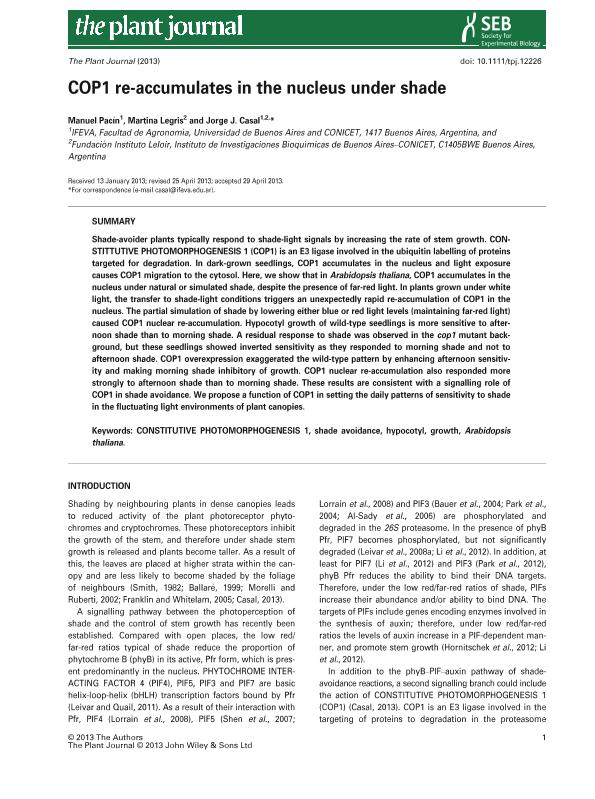Mostrar el registro sencillo del ítem
dc.contributor.author
Pacín, Manuel

dc.contributor.author
Legris, Martina

dc.contributor.author
Casal, Jorge Jose

dc.date.available
2017-06-02T19:59:27Z
dc.date.issued
2013-08
dc.identifier.citation
Pacín, Manuel; Legris, Martina; Casal, Jorge Jose; COP1 re-accumulates in the nucleus under shade; Wiley; Plant Journal; 75; 4; 8-2013; 631-641
dc.identifier.issn
0960-7412
dc.identifier.uri
http://hdl.handle.net/11336/17410
dc.description.abstract
Shade-avoider plants typically respond to shade-light signals by increasing the rate of stem growth. CONSTITTUTIVE PHOTOMORPHOGENESIS 1 (COP1) is an E3 ligase involved in the ubiquitin labelling of proteins targeted for degradation. In dark-grown seedlings, COP1 accumulates in the nucleus and light exposure causes COP1 migration to the cytosol. Here, we show that in Arabidopsis thaliana, COP1 accumulates in the nucleus under natural or simulated shade, despite the presence of far-red light. In plants grown under white light, the transfer to shade-light conditions triggers an unexpectedly rapid re-accumulation of COP1 in the nucleus. The partial simulation of shade by lowering either blue or red light levels (maintaining far-red light) caused COP1 nuclear re-accumulation. Hypocotyl growth of wild-type seedlings is more sensitive to afternoon shade than to morning shade. A residual response to shade was observed in the cop1 mutant background, but these seedlings showed inverted sensitivity as they responded to morning shade and not to afternoon shade. COP1 overexpression exaggerated the wild-type pattern by enhancing afternoon sensitivity and making morning shade inhibitory of growth. COP1 nuclear re-accumulation also responded more strongly to afternoon shade than to morning shade. These results are consistent with a signalling role of COP1 in shade avoidance. We propose a function of COP1 in setting the daily patterns of sensitivity to shade in the fluctuating light environments of plant canopies.
dc.format
application/pdf
dc.language.iso
eng
dc.publisher
Wiley

dc.rights
info:eu-repo/semantics/openAccess
dc.rights.uri
https://creativecommons.org/licenses/by-nc-sa/2.5/ar/
dc.subject
Constitutive Photomorphogenesis 1
dc.subject
Shade Avoidance
dc.subject
Hypocotyl
dc.subject
Growth
dc.subject.classification
Ciencias de las Plantas, Botánica

dc.subject.classification
Ciencias Biológicas

dc.subject.classification
CIENCIAS NATURALES Y EXACTAS

dc.title
COP1 re-accumulates in the nucleus under shade
dc.type
info:eu-repo/semantics/article
dc.type
info:ar-repo/semantics/artículo
dc.type
info:eu-repo/semantics/publishedVersion
dc.date.updated
2017-06-02T17:32:03Z
dc.journal.volume
75
dc.journal.number
4
dc.journal.pagination
631-641
dc.journal.pais
Estados Unidos

dc.journal.ciudad
Hoboken
dc.description.fil
Fil: Pacín, Manuel. Consejo Nacional de Investigaciones Científicas y Técnicas. Oficina de Coordinación Administrativa Parque Centenario. Instituto de Investigaciones Fisiológicas y Ecológicas Vinculadas a la Agricultura. Universidad de Buenos Aires. Facultad de Agronomía. Instituto de Investigaciones Fisiológicas y Ecológicas Vinculadas a la Agricultura; Argentina
dc.description.fil
Fil: Legris, Martina. Consejo Nacional de Investigaciones Científicas y Técnicas. Oficina de Coordinación Administrativa Parque Centenario. Instituto de Investigaciones Bioquímicas de Buenos Aires. Fundación Instituto Leloir. Instituto de Investigaciones Bioquímicas de Buenos Aires; Argentina
dc.description.fil
Fil: Casal, Jorge Jose. Consejo Nacional de Investigaciones Científicas y Técnicas. Oficina de Coordinación Administrativa Parque Centenario. Instituto de Investigaciones Fisiológicas y Ecológicas Vinculadas a la Agricultura. Universidad de Buenos Aires. Facultad de Agronomía. Instituto de Investigaciones Fisiológicas y Ecológicas Vinculadas a la Agricultura; Argentina
dc.journal.title
Plant Journal

dc.relation.alternativeid
info:eu-repo/semantics/altIdentifier/doi/http://dx.doi.org/10.1111/tpj.12226
dc.relation.alternativeid
info:eu-repo/semantics/altIdentifier/url/http://onlinelibrary.wiley.com/doi/10.1111/tpj.12226/abstract
Archivos asociados
